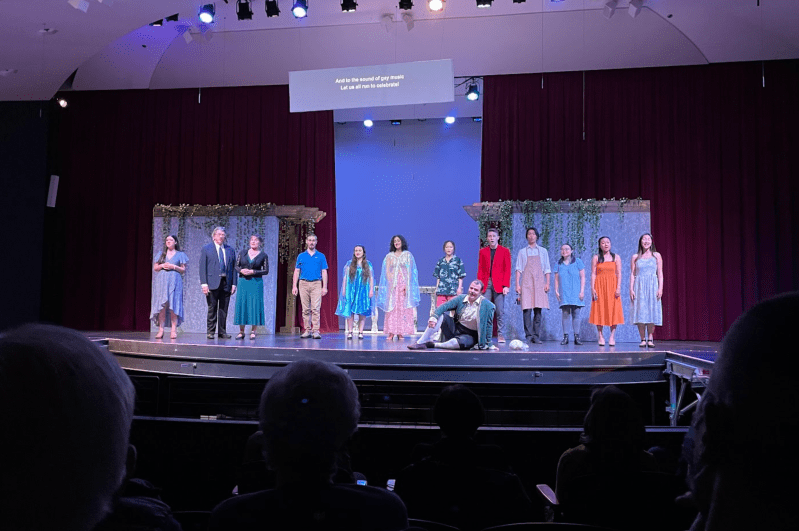Stepping into the Dinkelspiel Auditorium on Friday, my attention was immediately drawn by the cozy set lit by a soft, blue light and the orchestra’s accompanying joyful tunes. This past weekend, the Department of Music presented “Figaro’s Wedding,” a curtailed adaptation of Mozart’s famous opera “The Marriage of Figaro.” My curiosity had long been piqued by the line-up featuring Tony Award-winning singer Eugene Brancoveanu as the Count, as well as talented Stanford musicians.
From the very beginning, with the orchestra’s iconic Overture resounding in the auditorium, the production did not disappoint. The audience was initially disoriented by the opening aria “Un moto di gioia,” which had little to do with the plot. But the director’s adaptation soon grounded viewers in the production’s 21st century timeline, shaking things up instead of merely revising a 1786 opera, bringing to light contemporary themes of sexual consent and feminism.
The storyline remained unchanged from the original production: Susanna (performed by Nicolle Hendzel ’23 in the Apr. 1 and 3 shows and Jin Hee Lee ’23 in the Mar. 31 and Apr. 2 shows), the witty maid of Countess Rosina and fiancée of Figaro, the man-servant of the Count, becomes the sexual prey of the Count, who regularly attempts to force her into consenting to having sex with him. By exchanging garments, Susanna and the Countess (performed by Malaina Kapoor ’25 in the Apr. 1 and 3 shows and by Grace Davis ’22 in the Mar. 31 and Apr. 2 shows) trick the Count into rendezvousing with the latter dressed as Susanna, forcing him to repent his sins. Typical of Mozart’s opera buffas, “Figaro” highlights themes of human frailty and concludes with a comedic ending in which the Countess forgives her husband and Susanna marries her beloved. The central role of the female maid in the happy finale points to Mozart and his librettist Da Ponte’s departure from existing gender and class hierarchies. The Stanford production, incorporating modern elements like arranging a date via social media, makes the audience reflect on the story’s implication in the post-#MeToo era.
Above all, the production impressed me with the singers’ breathtaking delivery of arias and recitatives, relying on no amplification technology other than their vocal chords. Accompanied by the playful oboe and serene clarinet melodies, Susanna’s rich voice echoed in every corner of the hall, taking free and capricious twists and turns that led me on a rollercoaster of emotions; the Count’s booming exclamations exploded in my face with rage and desire. At times the voices of the characters layered into a satisfying, colorful harmony of conflicting wants and frustrations, with each layer expressing the inner monologue of each individual.
Reading the English translations of the Italian lyrics while keeping up with the actors’ movements is a perennial challenge when watching operas in other languages. However, I was still captivated by the humor each singer was able to embody across such barriers. Upon discovering the Count’s sexual predatory behavior towards his fiancée, Figaro’s (performed by Festival Opera singer Andrew Fellows) parody of the Count’s movements as he sang “If you want to dance, Sir Count, I’ll play the guitar for you” had me in a roar of laughter at his comical subversion of class hierarchies. In the end, Figaro dramatically opens his bosom to Susanna dressed as the Countess to torment her into thinking that he is throwing himself at the Countess, evoking chuckles from the audience. The Count, taking off his wig to show his flattened hair in repentance before the Countess, entertained the viewers as well as elicited their reflections on the wig as a symbol of patriarchal, feudal hierarchy. Devoid of the historic garment, the show once again situated me in the contemporary reality and reminded me of the gender inequality that persists to this day.
The character of Cherubino (Annette Dong ’24), dressed in a Hawaiian shirt, boyish shorts and tennis shoes, represents the intriguing overlap between the classical-era and modern understandings of gender. Cherubino is an adolescent page boy whose life is dictated by his awakening sexuality and is traditionally portrayed by a female singer. He is later clothed in female garments by the Countess, his new love-interest, who initially wants to use his feminine disguise to trick the Count. In effect, the actress portraying Cherubino has to go through two “drag” transformations. The Stanford production’s continuation of this tradition calls into question whether the core of gender expression — clothing and behavior — has changed since the 18th century. I was prompted to ponder how we can reform this performance norm according to the contemporary understanding of the fluidity of gender and oppressiveness of historic masculinity.
Overall, the Department of Music’s production of “Figaro’s Wedding” — with its overwhelming talent and thought-provoking themes — was a spectacle both entertaining and rewarding to the audience.
Editor’s Note: This article is a review and contains subjective opinions, thoughts and critiques.
